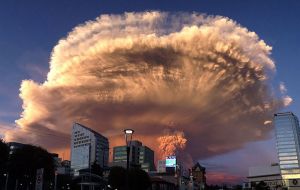MercoPress. South Atlantic News Agency
Antarctic ozone hole is finally starting to heal according to study published in Science
 “This is a reminder that when the world gets together, we really can solve environmental problems,” said Susan Solomon, an atmospheric chemist at MIT.
“This is a reminder that when the world gets together, we really can solve environmental problems,” said Susan Solomon, an atmospheric chemist at MIT.  Last October the ozone hole reached a record size of 23 million square kilometers, some 20 percent larger than the previous year.
Last October the ozone hole reached a record size of 23 million square kilometers, some 20 percent larger than the previous year.  The team was able to show that a string of eruptions at the Calbuco volcano in Chile widened the spring ozone hole.
The team was able to show that a string of eruptions at the Calbuco volcano in Chile widened the spring ozone hole. Nearly thirty years after an international treaty banned the use of chlorofluorocarbons, the Antarctic ozone hole is finally starting to heal. By mid to late century, it should be fully recovered.
“This is a reminder that when the world gets together, we really can solve environmental problems,” said Susan Solomon, an atmospheric chemist at MIT. “I think we should all congratulate ourselves on a job well done.”
Solomon is lead author on a study published today in Science, which presents the clearest evidence yet that the Antarctic ozone hole is showing signs of long-term recovery. The researchers attribute this to the 1987 Montreal Protocol, which banned the use of chlorinated compounds in refrigerator coolants and aerosols, after scientists learned that these chemicals were making their way into the stratosphere and wreaking havoc on Earth’s ozone layer.
Scientists have been monitoring the Antarctic ozone hole, which opens every year in late August or early September and reaches its full size by October, since the 1980s. The size of the ozone hole varies widely from year to year, because the chemical reactions that destroy ozone are highly sensitive to changes in sunlight, temperature, and stratospheric cloud cover. For researchers interested in tracking ozone recovery, the challenge lies in pulling a faint signal out of a noisy background.
This problem piqued the interest of Solomon and her co-authors last October, when the ozone hole reached a record size of 23 million square kilometers; some 20 percent larger than the previous year. “This was very unexpected, and we thought that the reason might have to do with volcanoes,” Solomon said, explaining that the aerosols released during volcanic eruptions contribute to polar stratospheric clouds, creating additional surface area for ozone-destroying reactions to occur.
Sure enough, the team was able to show that a string of eruptions at the Calbuco volcano in Chile widened the spring ozone hole. But they discovered something else, too. “We learned that September is not nearly as variable in weather as October, and that it’s less sensitive to volcanic activity,” Solomon said.
This got the researchers thinking that September may be the best month for teasing out subtle signs of ozone recovery. So they assembled September records from 2000 to 2015, including data on the rate at which the ozone hole opens, its average size and depth, meteorological conditions and volcanic activity.
“We found that because there is less chlorine in the atmosphere, the ozone hole is opening about ten days later than it used to,” Solomon said. “That has a huge effect on the September average.” Overall, Solomon’s analysis showed that the September ozone hole has shrunk by an average of 4.5 million square kilometers since 2000.




Top Comments
Disclaimer & comment rules-

-

-

Read all commentsSure.
Jul 02nd, 2016 - 03:43 pm 0Has Argentina claimed that hole yet?
Jul 03rd, 2016 - 04:33 pm 0A glimmer of hope on humankind's capacity to backtrack on suicide practices when the drawbacks become clear.
Jul 04th, 2016 - 12:29 am 0However, much remains to be done. We need to revert global warming, a much more difficult challenge than changing the propellant gaz in spray containers.
We need to stop the oceans' pollution as well.
The use of renewable forms of energy together with new ways of reducing consumption will help in the task, climate change deniers be damned.
Commenting for this story is now closed.
If you have a Facebook account, become a fan and comment on our Facebook Page!